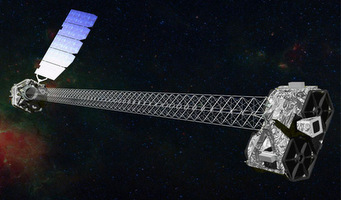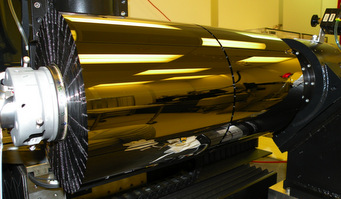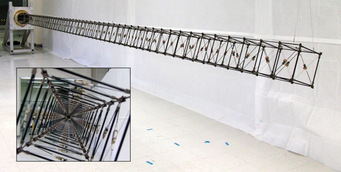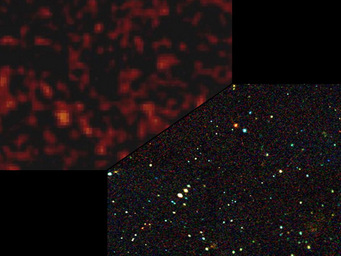After 20 years of planning, the NuSTAR X-ray telescope launched today from an island in the Pacific.

Artist's concept of NuSTAR in orbit. The 10-meter (30-foot) mast separates the optics modules with the nested mirrors (right) from the digital camera (left). The background image is a view of the Galactic Center as seen by the Chandra X-ray Observatory at lower X-ray energies.
NASA / JPL-Caltech
NuSTAR, the first telescope to focus very high-energy X-rays, launched successfully from Kwajalein Atoll at 9:00 a.m. Pacific time. NuSTAR will collect X-rays in the energy range of 6 to 79 keV, similar to the energy range of medical X-rays. Most X-ray astronomy has been done at lower energies, where X-rays are less difficult to focus. But rather than penetrate skin and muscle to look for broken bones, NuSTAR’s X-rays penetrate dust and gas to reveal supernova remnants and the flicker of gas around feeding black holes, where high-energy processes abound
To place NuSTAR in an equatorial, low-Earth orbit, one that will avoid interference from energetic charged particles trapped in Earth’s magnetic field, the launch had to take an unusual form. An L-1011 Stargazer aircraft climbed to 40,000 feet before dropping a Pegasus XL rocket strapped to its belly. The rocket fell for 5 seconds before igniting the first of three stages to carry NuSTAR into orbit. Watch a video of a Stargazer-Pegasus launch here:
NuSTAR was originally scheduled for launch in March, but a problem (now fixed) in the flight software delayed the launch by three months. For principal investigator Fiona Harrison (California Institute of Technology), three months was a drop in the bucket compared to the 20 years she has dedicated to this mission.
To build NuSTAR, Harrison and colleagues had to develop several new technologies. “Focusing [high-energy] X-rays calls for a new way of doing business,” says instrument manager William Craig (UC Berkeley). Unlike visible light, which comes to a focus when photon paths bend through a lens or bounce straight off a mirror, X-rays have too much energy, and too short a wavelength, to be directed in this way. If you send X-rays straight at a mirror, they’ll pass right through.

NuSTAR's two optics modules each contain 133 nested mirrors. This picture shows the first optics module midway through assembly with 82 nested mirrors.
www.nustar.caltech.edu
Instead, NuSTAR’s mirrors will deflect the X-rays by bouncing them at a very low “grazing incidence” angle barely skimming the mirrors. This method has long been used in other X-ray telescopes, but NuSTAR’s design is more extreme. With 133 mirrors nested inside one another in each of two optic units, NuSTAR can focus enough high-energy X-rays to make images ten times crisper and 100 times more sensitive than what is currently possible. Each image can be broken down into a spectrum with ten times the spectral resolution currently possible at these energies.
“It’s rare you get the chance of increasing a sensitivity factor by more than 100 times better than current methods,” says Bill Craig (Lawrence Livermore National Laboratory). “This is really a game changer.”
NuSTAR’s mirrors came surprisingly cheap — only $20 per sheet — because the mirrors are made of the same glass used in laptop displays. Each mirror has a special reflective coating only a few atoms thick.

NuSTAR's mast will deploy to the length of a school bus, separating the camera from the mirrors so that X-rays can be brought to a focus. This image shows a mast deployment test done in August 2009.
www.nustar.caltech.edu
Because the X-rays bend so slightly when they graze off the nested mirrors, they come to a focus at a great distance. So the camera imaging has to be placed far from the mirrors. A lightweight, but incredibly stiff mast holds the cameras 10 meters (33 feet) from the mirrors. This mast is a scaled-down version of a longer mast used successfully in a previous radar topography mission. The full-length mast wouldn’t fit in a Pegasus rocket, so it was folded up for launch. The whole telescope was no bigger than a refrigerator this morning. But roughly a week from today, scientists and engineers will be biting their nails as the mast deploys, each part unfolding and locking like a Tinkertoy set. See the simulation here:
Three weeks after the mast is deployed, the telescope should be ready for science operations. The primary mission is set for two years, but NuSTAR's mission could potentially be extended several years beyond that. Among its many targets are spinning black holes, radioactive titanium shining in supernova remnants, and the Sun’s atmosphere.

The ESA's Integral satellite took the fuzzy picture on the upper left, showing X-rays from galaxies far beyond our own. NuSTAR will be able to resolve the fuzzy image into distinct sources, as demonstrated by the simulation on the lower right.
ESA / NASA / JPL-Caltech
The launch of NuSTAR, a NASA Small Explorer mission, comes at an interesting time: even as X-ray astronomy celebrates its 50th anniversary, the next major X-ray observatory (the International X-ray Observatory) has been cancelled, and no major X-ray telescopes are planned for the near future. X-ray astronomers will depend on smaller satellites with shorter expected lifetimes, such as NuSTAR and the Japanese ASTRO-H (set to launch in 2014), as well as aging observatories, such as Chandra and XMM-Newton, to advance the field over the next decade or two.
 4
4
Comments
Kevin
June 15, 2012 at 12:17 pm
Well done on the launch, the use of 'off the shelf' glass, and the unique mast design and deployment system. I couldn't help but notice the strong resemblance between NuSTAR and DISCOVERY from '2001'. The long mast just might make NUSTAR visible for satellite spotters like myself.
You must be logged in to post a comment.
Anthony Barreiro
June 15, 2012 at 4:28 pm
Kevin, that's an interesting idea, to look for NuSTAR. http://www.orbital.com/newsinfo/missionupdates/NuStar/ says that NuSTAR will be in an equatorial orbit at an altitude of approximately 600 km -- that seems pretty low. I've never been very good at math. From latitude 37 degrees north, how high will NuSTAR get in my sky?
You must be logged in to post a comment.
Bruce
June 15, 2012 at 9:46 pm
Sorry Anthony, but I calculate that NuSTAR would cross your meridian about 14 degrees below your horizon. An object in an equatorial orbit at your latitude would need to be 1,608 km high to even touch your horizon.
You must be logged in to post a comment.
Richard
June 20, 2012 at 6:12 am
I am surprised that the video clip describes the air-launch system as "unique." It is definitely NOT unique. Burt Rutan even launched his Spaceship One using this technique. Let's stick to giving credit where credit is due!
You must be logged in to post a comment.
You must be logged in to post a comment.